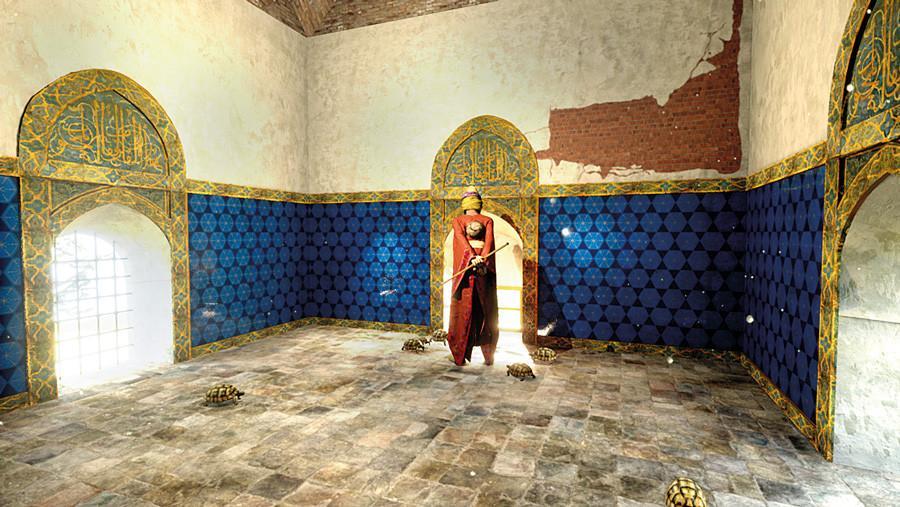
Suna and İnan Kıraç Foundation Pera Museum revives Osman Hamdi Bey’s “The Tortoise Trainer,” one of the best-known works of Turkish painting, with a virtual reality project.
The project was launched on the 15th anniversary of the inclusion of the painting in the Suna and İnan Kıraç Foundation’s Orientalist Painting Collection.
The project, titled “A Journey into the World of Osman Hamdi Bey: Virtual Reality Experience,” by Muse VR enables the audience to travel back in time to early 1906 and experience this famous art inside Osman Hamdi Bey’s working space.
This experience, enriched with works from the “Orientalist Painting,” “Anatolian Weights and Measures” and “Kütahya Tiles and Ceramics” collections of Suna and İnan Kıraç Foundation, reflects the characteristics of the period with great attention to detail and invites aesthetes into Osman Hamdi Bey’s studio.
The audience has the opportunity to explore many details from the artist’s books sitting on his desk to his paintings, his glasses and brushes to photographs, and can also step inside “The Tortoise Trainer” painting.
Noting that the social landscape was being transformed with the fast-paced advancement in technology and that this transformation entailed a change in the museum concept, Suna and İnan Kıraç Foundation Culture and Arts Enterprises general manager Özalp Birol said in a statement that they designed a new experience for art lovers by expanding the museum experience beyond the physical limitations of the museum space.
“With virtual reality, we are making the museum experience more personal and interactive, thus more immersive for our visitors. This project gives valuable insights into one of the most precious works of Turkish painting: Osman Hamdi Bey’s ‘The Tortoise Trainer,’ which we added to our collection 15 years ago,” Birol said.
Visitors can find this experience in the special section devoted to Osman Hamdi Bey at the Sevgi and Erdoğan Gönül Gallery free of charge.
[HH] The Art of Osman Hamdi Bey
For Osman Hamdi Bey, who was primarily defined as a man of culture and arts, painting was a lifelong passion that he wanted to devote more time into to further develop his skills.
Following his art education in Paris, Osman Hamdi Bey submitted his paintings to major exhibitions held in the country capitals across Europe.
His works were influenced by the aesthetic approach and tendencies dominating the art circles of Paris, mainly orientalism. The artist brought a new breath to Turkish painting with his monumental figure works.
The scenes he created with figures are remarkable in terms of their stylistic similarities with the works of leading Western orientalist painters such as Jean-Leon Gérôme, Rudolf Ernst and Ludwig Deutsch.
On the other hand, Osman Hamdi Bey’s approach to orientalism, which observes the East from within, differs from western painters. His paintings do not depict violence and eroticism, which sometimes serve as powerful elements of expression in orientalist works. The figures dressed in Ottoman clothes are shown in an eastern setting surrounded by eastern objects.
For the male figures in his paintings, he often used his own photographs in which he posed in different clothes, and sometimes asked his family and close relatives such as his son or nephew to be his models.
In addition to the orientalist scenes, portraits of his family members and relatives and especially landscapes from Gebze and Eskihisar also occupy a large place in his works. In these paintings by Osman Hamdi Bey, we see that, instead of the academic style in which all the details are elaborated, a more freestanding brush technique reminiscent of impressionism was used.
The Tortoise Trainer
The “Tortoise Trainer,” which was on display at the Salon exhibition organized by Societe des Artistes Français on May 1, 1906 with the French title “L’homme aux Tortues” (the Man with Tortoises) and named simply as “Tortoises” in English in one of the exhibition catalogues.
The date “1906” on the painting suggests that it must have been completed in the first months of the year in order to have it ready for the exhibition in May.
Osman Hamdi Bey died on Feb. 24, 1910 in his waterfront mansion in Kuruçeşme at the age of 58, a few years after completing “The Tortoise Trainer.”